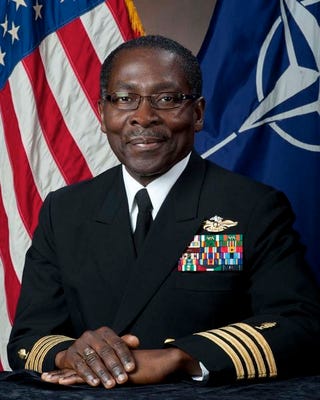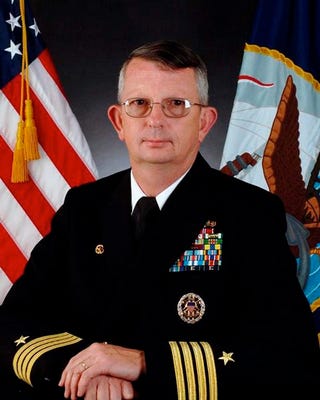source GAIA package: Sx_MilitaryTimes_M6201310302260321_5675.zip Origin key: Sx_MilitaryTimes_M6201310302260321 imported at Fri Jan 8 18:18:08 2016
Know your 'Old Salts'
Capt. (Dr.) Peter Soballe Age: 66 Time in service: 45 years, 6 months Branch: Medical Corps Current command: Naval Medical Center San Diego Career highlights: Chair of the surgery department at NMC San Diego. Capt. John Schultz Age: 58 Time in service: 40 years, 6 months Branch: Surface Warfare Current command: Submarine Group 7 Career highlights: Rose to master chief, then commissioned. Has commanded three ships. Capt. James Brokaw Age: 57 Time in service: 39 years, 7 months Branch: Information Warfare Current command: Navy Information Operations Command Georgia Career highlights: A former chief crypotologic technician, he took command of NIOC Georgia in August 2012. Capt. Marc Waterman Age: 66 Time in service: 40 years, 7 months Branch: Dental Corps Current command: 11th Dental Company, Camp Foster, in Okinawa, Japan Capt. Rupert Lindo Age: 57 Time in service: 39 years, 5 months Branch: Medical Service Corps Current command: NATO Allied Command Transformation in Norfolk, Va. Career highlights: Commanded a deployed medical support company during Operation Desert Storm. Cmdr. Rafael Perez Age: 58 Time in service: 40 years, 7 months Branch: Medical Service Corps Current command: Branch Medical Clinic, Marine Corps Recruit Depot San Diego Career highlights: Deployed with Marine unit to Fallujah, Iraq, and served as medical officer for Combat Logistics Group 15 in Helmand Province, Afghanistan.
The Oldest Salt works in a nondescript office in San Diego.
 His active-duty career spans nine presidents, six major conflicts, the fleet's shrinkage three times over. He has been a Navy captain for a quarter-century.
His active-duty career spans nine presidents, six major conflicts, the fleet's shrinkage three times over. He has been a Navy captain for a quarter-century.
 When he was commissioned as an ensign, the current chief of naval operations was 14 years old.
When he was commissioned as an ensign, the current chief of naval operations was 14 years old.
 So why has Capt. (Dr.) Peter Soballe stayed in the Navy for 45 years and six months?
So why has Capt. (Dr.) Peter Soballe stayed in the Navy for 45 years and six months?
 "It's fun," said Soballe, 66, the head of the surgery department at Naval Medical Center San Diego. He went on to tell a sea story.
"It's fun," said Soballe, 66, the head of the surgery department at Naval Medical Center San Diego. He went on to tell a sea story.
 He and a resident surgeon had finished an appendectomy one night — in the 1980s, Soballe recalled — when the resident said: "'Gee, I hope the Navy never finds out that they wouldn't have to pay me to do this. I'd probably pay them!'" Soballe recalled with a laugh.
He and a resident surgeon had finished an appendectomy one night — in the 1980s, Soballe recalled — when the resident said: "'Gee, I hope the Navy never finds out that they wouldn't have to pay me to do this. I'd probably pay them!'" Soballe recalled with a laugh.
 "You know, sometimes it gets serious, don't get me wrong, but most of the time, you're helping people, and you get instant gratification."
"You know, sometimes it gets serious, don't get me wrong, but most of the time, you're helping people, and you get instant gratification."
Everyone knows a sailor who's counting down the years, months, days — even minutes — until he hits the 20-year retirement mark … and hits the door running. But there are those like Soballe who stay much longer — by choice. Among these Navy stalwarts is an even more standout group: the six officers who have served nearly four decades or more, according to Navy Personnel Command. Some of them initially joined for a tour or to pay for college, but ended up staying because of the work, the camaraderie, the possibility of command.
These officers aren't traditionally recognized for such an achievement. There is no Navy-wide "Order of the Old Salt" or handoff ritual, like there is within the surface fleet, no Pentagon photo-op. Soballe learned he was the longest-serving active-duty person when he was contacted by Navy Times.
The doctors and dentists on the list are part of a special program that waives their high-year tenure rules. And the other three officers served for years as enlisted, time not tallied toward their seniority as officers — but which nonetheless imparts considerable authority and insight. Any of the old salts over the age of 62 must apply for a waiver to continue serving, up to the age limit, 68.
All of these old-timers joined the Navy while the Vietnam War was raging and have weathered two drawdowns. They have been in the Navy longer than the Master Chief Petty Officer of the Navy (AW/NAC) Mike Stevens, who enlisted in June 1983, or the longest-serving admiral, Chief of Naval Operations Adm. Jon Greenert, who was commissioned in 1975. All four officers interviewed for this article — two could not be reached by press time — come from different Navy branches and have different perspectives, but agree on one point: Sailors should think again before leaving the Navy.
"We have so much talent that punches out at their 20-year mark," said Capt. James Brokaw, an information warfare officer who has served nearly twice as long: 39 years, seven months, to be exact. "There can be success after the 20-year retirement-eligibility point."
The Oldest Salt
Soballe, the head of surgery, was considering retiring from the military in the mid-1990s. He'd been in long enough to qualify for retirement and could go into private practice, where more money could be made. The only problem: Soballe kept looking for jobs like the one he already had.
Then he came across the Retire-Retain program. It exempts officers in fields where professional degrees are required from HYT ceilings. This includes those like chaplains and doctors, whose senior billets don't require as much stamina for their work and who often grow more skilled — and valuable to the Navy — later in their careers.
There are only two catches to Retire-Retain, as Soballe saw it: You have no fitness reports, and you won't get promoted.
"I said, 'Well, that's cool,'" said Soballe, who had preferred to remain a practicing surgeon. "This is a wonderful thing."
In his view, things have gotten easier ever since. He's grown better as a surgeon. He's gotten better jobs, including serving as the senior medical officer at the Expeditionary Medical Facility in Djibouti. Even the physical readiness test has gotten easier.
"It was relatively difficult to score outstanding back when I was 40, but it's basically show up and fog the mirror now and it's an outstanding," he said, chuckling.
And Soballe believes his experience is how the Navy's Medical Corps should work, arguing that the key to success in medicine is to develop an expertise and stick with it. High-year tenure rules, he says, are "counterproductive."
"If you talk about up-and-out or high-year tenure, in this particular area of the military, I think it's a serious mistake and it's led to a lot of weaknesses we don't need to have in the Medical Corps," Soballe said. "Most surgeons are just hitting their stride at age 50."
Having been a department head more than half his life, Soballe believes the most essential element of success is being a self-starter. Part of this involves not needing constant approval.
"I think one reason people move on after such a short period is like, 'Well, I've got my medal for this, I'm going to go on and do something else,'" Soballe said. "They never, kind of, get over the need for that outside approval. And by the way, that's built into the military hierarchy, isn't it?
"Nobody, but nobody, knows all of those things that you do everyday," continued Soballe, who plans to retire in June. "So you yourself have to feel like this is worthwhile, that you're doing a good job, or you might as well move on."
'Keep pressing forward'
John Schultz didn't plan to make the Navy a career. He enlisted Aug. 18, 1972, and became a sonar tech.
"I never actually intended to stay in, but every time it was time to get out, an opportunity presented itself and I stayed," said Schultz, now a 58-year-old captain. "That may seem odd. I never came in to make the Navy a career, but here I am."
Schultz served as a sonar tech aboard one sub and two ships and rose rapidly through the ranks. After 14 years, he advanced to master chief. A few years before, he earned his bachelor's degree from Chapman College and was chosen for limited duty officer in 1987.
Schultz said his choices over the decades distilled down to one drive: To command a warship.
In an unusual career move, Schultz shifted over to surface warfare and got the opportunity he had sought: he commanded coastal patrol craft Monsoon, coastal minehunter Cardinal and the frigate McClusky. He finished his major command tour as the commodore of Yokosuka, Japan-based Destroyer Squadron 15 last December.
"Having been a chief and then advancing through the chief ranks, I knew what I was up against," recalled Schultz, who became a SWO as a lieutenant j.g. 25 years ago. "Basically, it was just try to learn as much as I could. Do the best I could do. I was lucky that the leaders that I worked for understood what my background was. As you would expect, they expected more out of me."
Schultz admitted he'd experienced a setback early in his career — "Not something I would want published," he said — and recalled that it was all too easy to give up.
"For the young guys, when it gets hard, don't give up," Schultz advised. "Keep pressing forward."
Schultz found inspiration in the leadership mantra of Hall of Fame football head coach Vince Lombardi.
"In his terms, you don't play football to come in second place," said Schultz, who adapted this to his command philosophy. "And in the military, I think that's exactly right on the money for us. We don't play to come in second place in the Navy."
Schultz is the only unrestricted line officer among those with four decades of service. He plans to keep going. He has four more years until he hits his high-year tenure — 30 years of commissioned service.
The Navy was also a great opportunity for Rupert Lindo, a Jamaican-born man raised in Brooklyn, N.Y., who enlisted Sept. 20, 1973, and became a hospital corpsman. Lindo advanced to petty officer first class and was commissioned into the Medical Service Corps after 12 years in. As a lieutenant, he commanded a collecting and clearing company with Second Medical Battalion, 2nd Force Support Group that supported Operation Desert Storm. And in the Navy, Lindo earned a bachelor's and three master's degrees.
Lindo, now a captain assigned to NATO Allied Command Transformation in Norfolk, Va., said his success stemmed from self-discipline, courage, perseverance and personal faith.
So why has he stayed in for so long?
"Forty years," he pondered in an interview, pointing out that he has submitted his retirement papers for October. "It's really hard to just put it in a few minutes like this. But it has been a very good experience. I've enjoyed the camaraderie.
"You don't think about doing 40 years or 30 years or whatever," he added. "Take it one day at a time."
'It's not about you'
The Navy was supposed to be a quick ride for Brokaw, the information warfare officer. When he was a teenager, his brother was stationed in the Philippines. Thinking this sounded far out, Brokaw enlisted July 26, 1973. He was 17, so his mother signed the papers.
"I thought a hitch in the Navy would allow me to gain some maturity, save some money, get the GI Bill, and after one term in the Navy I go back home and go to college," recalled Brokaw, who now commands the 1,300-person Navy Information Operations Command in Augusta, Ga. "But things changed. I fell in love with first the sea and then the Navy."
Brokaw, who trained as a Russian linguist at the Defense Language Institute in Monterey, Calif., enjoyed duty aboard submarines, where pride and professionalism still reigned amid a fleet suffering from cuts and demoralization. He enjoyed working at sea, known in the lingo of cryptology branch as "direct support" missions.
Brokaw rose through the ranks. After nine years, he'd made chief and had his sights set on master chief when an officer convinced him to submit a package for cryptologic limited-duty officer. He was picked up.
Transitioning from the chief's mess to the wardroom was difficult, one that required "introspection," Brokaw said. But a mustang officer brings a fuller understanding of how things get done on the deck plates — an advantage that can help him be more effective than other leaders.
One lesson Brokaw took away from his enlisted years was the centrality of the leading petty officer.
"I've always felt that it's the chiefs that make the Navy run, but LPOs are truly the linchpin because they connect the chiefs with the deck-plate sailors," Brokaw said, calling this an insight that's helped him throughout his career. "I focus a lot of attention on the LPOs because it really is the LPOs ... particularly at a command this large, that know or need to know their sailors."
Seeking additional command opportunities, Brokaw transferred to the Information Warfare community. As a commanding officer, Brokaw said he spends a lot of time asking his chiefs about their LPOs, noting that they will be the next of chiefs. He believes the key to success is devotion.
"It starts with commitment to service," Brokaw said. "Accept the fact that it's service; it's not about you. You've got to be ready to do or go whenever our Navy calls you; that's [a] great start."
Take that attitude to heart by dedicating yourself to the job you have, treating it as the best job the Navy offers, Brokaw advises his officers.
Much of Brokaw's enlisted career was during the post-Vietnam drawdown. At the time, drug use and racial tensions were common onboard ships, he recalled.
"After my first two surface-ship deployments, I was wondering what I got myself into," he said, adding that he changed his mind and decided to stay in once he served aboard subs, where discipline was higher and sailors were more professional.
The Navy again faces budget woes as it did in those days, including the specter of a "hollow" force, unable to meet its missions. But today's Navy is in a much better state than it was then, Brokaw said.
"In my view, the good old days weren't. We are a much better Navy now with just incredibly bright, educated and dedicated sailors. And we do a much better job taking care of them now."





